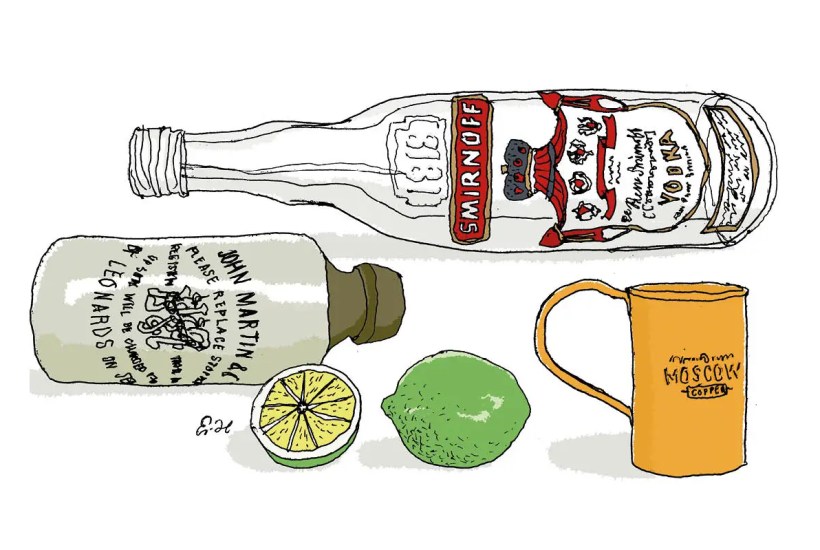If called upon to declare the seven greatest cocktails of all time — a Magnificent Seven, as it were — what would be your lineup?
The struggle is less in naming seven than in sticking to so few. The ubiquitous gin and tonic must be on the list, of course, along with the Old Fashioned. And surely the Bloody Mary deserves a place… but can the Bellini be left out? And is it legitimate to include not one but two brunch cocktails, when we haven’t even mentioned the mighty Ms — martinis, mojitos, margaritas and Manhattans? We’re already past seven, and what about the whisky sour, the Negroni and the Long Island iced tea?
But speaking of mighty Ms, there’s one drink to rule them all, one drink to find them, one drink to bring them all and in the barroom bind them. It is the Moscow mule. The origins of this fabulously refreshing fizz are, despite the Russian reference, all-American: a fairytale pairing of consumer capitalism and dogged entrepreneurship.
Once upon a time — or so this version of the story goes — one John G. Martin, of Hartford, Connecticut, purchased the rights to Smirnoff Vodka. It was just before World War Two, and the drinking public didn’t care for vodka. Martin toiled from bar to bar across America, talking up Smirnoff with increasing frustration as bartender after bartender waved the stuff away. It was in LA that he finally struck — er, copper.
There he met with a kindred spirit, a pub owner who had been trying to open the American consumer’s mind to another product — a house brand of ginger beer. He and Martin had much to commiserate over, for his ginger-beer pitch had met with same lackluster enthusiasm as Martin’s Smirnoff sales.
As they sat together bemoaning their plight (doubtless over a little something on the rocks), the pair were suddenly visited by genius. Why not pool their resources — literally, pouring their respective beverages into a single cocktail glass? The vodka would sell the ginger beer, and the ginger beer would sell the vodka, and a little lime juice would sweeten the deal.
So far, some or much of the above is true. Sort of. The next bit of the story strains credulity somewhat. At any rate, another member of the dramatis personae is supposed to have entered the tale at this point, a Russian immigrant named Sophie Berezinski. Berezinski’s father is said to have owned and operated a copper factory back in Mother Russia, where he used the stamping presses to produce copper mugs that Sophie herself had designed. When Sophie and her husband immigrated to the land of freedom and opportunity, they brought 2,000 mugs along, intending to sell them.
But the mugs, like the Smirnoff and the ginger beer, struggled to find buyers. The 2,000 mugs cluttered up the Berezinski home until finally Sophie’s husband got tired of seeing them and instructed his wife to get rid of them. In a last desperate bid to find a buyer, she happened into the pub where Martin and his friend were, armed with sample mugs. Somehow the men were convinced that what their new cocktail needed was a signature cup, and in a happy ending for the Berezinskis, Sophie’s copper mug became the third ingredient in what was to become a great commercial success. After a little time spent tweaking the recipe, America was treated to the sight of the first Moscow mule, harnessed in coppery trappings, trotting up to the bar, ears laid well back, spluttering slightly due to the ginger beer’s carbonation.
John G. Martin resumed his sales rounds, this time with a case of copper mugs and a photo album. He would get the bartender to mix up a Moscow mule in one of his signature copper mugs, then hold up the drink with a smile while he snapped two Polaroids — one for the barman to put up on the wall, the other to add to his photo collection, which he would show at the next joint as proof of the mule’s wild popularity.
Simplicity is one of the hallmarks of greatness, and the Moscow mule recipe is a shining example of this rule. Two ounces of vodka, four ounces of ginger beer and half an ounce of lime juice are poured into a mug full of ice and garnished with a slice of lime. Thanks to the high conductivity of copper, the mug quickly takes on the icy temperature of the mixture, keeping the drink extra cold. (That said, in some places health regulations require mule mugs to be lined with nickel or stainless steel, because it’s feared the drink’s high acid content could break down copper molecules, allowing toxic particles to mix with the beverage.)
The word “Moscow” in the name is, of course, a reference to the Smirnoff — and perhaps to the Russian copper mugs as well. The “mule” is for the drink’s gingery kick. But the obstinacy with which the drink dug itself into cocktail culture — it has yet to budge, as a matter of fact — is mule-like too. More than eighty years later, the Moscow mule remains one of the most popular mixed drinks in America.
There are any number of spin-offs, of course. The Irish mule is a very successful one, replacing the vodka with Irish whiskey. The Kentucky mule uses bourbon instead. The Gin-Gin mule features, as you might expect, the juniper-berry-flavored distillation so often sold in blue bottles, and the Mexican mule swaps in tequila. Some say you can use ginger ale instead of ginger beer, but I’ve tried this, and there is no need for anyone else to.
They say if life gives you lemons, you should make lemonade. If life gives you vodka, ginger beer and lime, well, it’s easy to find the silver lining inside the cloud. Fetch out the ice tray and the lime squeezer, and above all remember that when ginger beer is in the picture, it’s the one time to ignore the admonition of James Bond: not shaken. Just stirred.
This article was originally published in The Spectator’s September 2023 World edition.
The post In praise of the Moscow mule appeared first on The Spectator World.
Got something to add? Join the discussion and comment below.
Get 10 issues for just $10
Subscribe to The Spectator Australia today for the next 10 magazine issues, plus full online access, for just $10.




















Comments
Don't miss out
Join the conversation with other Spectator Australia readers. Subscribe to leave a comment.
SUBSCRIBEAlready a subscriber? Log in